Telluride, Colorado 作者: 来源: 发布时间:2021-07-20
I.Population and Area
₋Area
Land: 2.22 sq mi (5.76 km2)
₋Population
Total: 2,325
Density: 1,115.66/sq mi (430.75/km2)
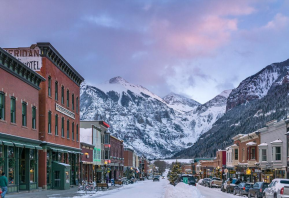
II.Natural Geography
₋Telluride is the county seat and most populous town of San Miguel County in the southwestern portion of the U.S. state of Colorado. The town is a former silver mining camp on the San Miguel River in the western San Juan Mountains. The first gold mining claim was made in the mountains above Telluride in 1875, and early settlement of what is now Telluride followed. The town itself was founded in 1878 as "Columbia", but due to confusion with a California town of the same name, was renamed Telluride in 1887 for the gold telluride minerals found in other parts of Colorado. These telluride minerals were never found near Telluride, but the area's mines for some years provided zinc, lead, copper, silver, and other gold ores.
₋Telluride sits in a box canyon. Steep forested mountains and cliffs surround it, with Bridal Veil Falls situated at the canyon's head. Numerous weathered ruins of old mining operations dot the hillsides. A free gondola connects the town with its companion town, Mountain Village, Colorado, at the base of the ski area. Telluride and the surrounding area have featured prominently in popular culture, and it is the subject of several popular songs. It is especially known for its ski resor t and slopes during the winter, as well as an extensive festival schedule during the summer.
₋The Telluride Historic District, which includes a significant portion of the town, is listed on the National Register of Historic Places and is also one of Colorado's 20 National Historic Landmarks. The town population was 2,325 in the 2010 United States Census.
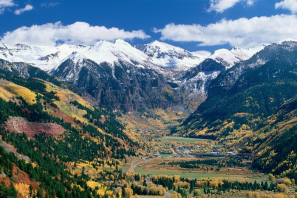
III.GDP
₋The average salary in Telluride, CO is $51k. Trends in wages decreased by -100.0 percent in Q1 2020. The cost of living in Telluride, CO is 100 percent higher than the national average. The most popular occupations in Telluride, CO are Executive Chef, Operations Manager, and Director of Operations which pay between $36k and $95k per year. The most popular employers in Telluride, CO are Telluride Ski and Golf and Clark's Market.
₋Website: https://www.payscale.com/research/US/Location=Telluride-CO/Salary
IV.Industrial Characteristics
₋Tourism
₋Beyond the ski lifts, Telluride is now widely recognized as an all-season resort. Telluride Ski Resort is definitely the main attraction in the winter. But when summer comes around, Telluride transforms into an outdoor recreation hot spot, with tourists visiting to enjoy mountain biking, hiking, river rafting, sightseeing and more. The Telluride Tourism Board promotes tourism in the region.
₋Telluride features over 30 hiking trails ranging in difficulty level. Some of the more popular routes include Ajax Peak, Bear Creek Falls, Hope Lake, and Bridal Veil Falls. Hiking season begins in May and lasts until early October, with waterfalls gushing in June and wildflowers at their peak in early July. The trails range from quick and easy runs to multi-day hiking trips that reach an elevation of 14,000 feet. Nearly all the trails feature waterfalls, wildflowers, and high alpine lakes.
₋Telluride is also home to many endurance events. The Hardrock 100, held in July, has a major aid station in the town park. The Fall Tilt, a 12-hour downhill mountain biking event, is held in Mountain Village each September. And the 40-mile Telluride Mountain Run loops the town in a wide swath that includes some of the most difficult and scenic trails in the area.
V.Attractions
1.Telluride Ski Resort
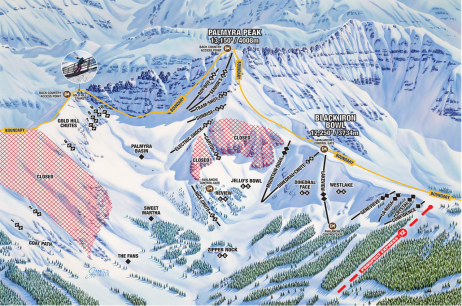
₋Telluride Ski Resort is a ski resort located in Mountain Village, Colorado right next to the Town of Telluride.
₋The Telluride Ski Resort is a year-round destination located in the southwest corner of Colorado. The resort is in the northwestern San Juan Mountains, part of the Rocky Mountains, and is home to the highest concentration of 13,000 and 14,000 foot peaks in North America.
₋Telluride Ski Resort has over 2,000 skiable acres and spans between the historic town of Telluride, Colorado and the modern alpine community of Mountain Village, Colorado. Telluride began as a mining camp in the late 1800s and is currently a National Historic Landmark District.
₋While Telluride is well known for its advanced terrain the resort has over 50% beginner and intermediate runs. The top of resort features primarily expert and advanced terrain.
₋Telluride is located 330 miles from Denver, Colorado. The Ski Resort has been ranked #1 in the annual Conde Nast Traveler's Reader's Choice Survey in 2013, 2014 and 2015 and was named #1 small city in America in 2015.
₋Address: 565 Mountain Village Blvd, Telluride, CO 81435, United States
₋Website: http://www.tellurideskiresort.com/
2.Bridal Veil Falls
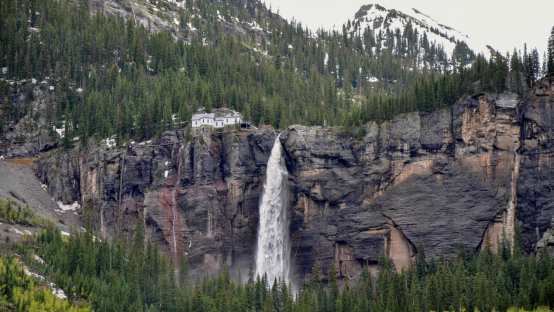
₋Bridal Veil Falls is a 365-foot (111 m) waterfall at the end of the box canyon overlooking Telluride, Colorado. Hiking and off-road trails pass by the falls and it has a hydroelectric power plant at its top. In winter the frozen shape of the falls forms an imposing challenge to intrepid ice climbers.
₋Bridal Veil Falls are a two-pronged waterfall. The area around Bridal Veil Falls is subject to avalanche and controlled shelling to create controlled slides is an event popular with spectators and photographers. Reaching the top of the falls in winter can be a precarious venture, even for the experienced family that lives there.
₋A hiking trail continues on past the falls to mountain meadows and mountain lakes above 10,000 feet (3,000 m).
₋Website: https://www.outdoorproject.com/united-states/colorado/bridal-veil-falls-telluride
3.Mount Sneffels
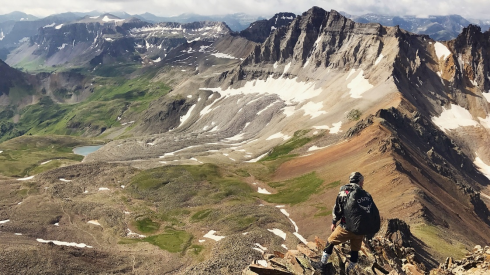
₋Mount Sneffels is the highest summit of the Sneffels Range in the Rocky Mountains of North America. The prominent 14,158-foot (4315.4 m) fourteener is located in the Mount Sneffels Wilderness of Uncompahgre National Forest, 6.7 miles (10.8 km) west by south (bearing 256°) of the City of Ouray in Ouray County, Colorado, United States. The summit of Mount Sneffels is the highest point in Ouray County.
₋Mount Sneffels is notable for its great vertical relief, as it rises 7,200 feet above the town of Ridgway, Colorado 6 miles to the northeast.
₋The primary route to the summit follows a creek bed up from Yankee Boy Basin. A secondary route follows a ridge line to the summit from the saddle of Blue Lakes Pass.
₋Mount Sneffels was named after the volcano Snæfell, which is located on the tip of the Snæfellsnes peninsula in Iceland. That mountain and its glacier, Snæfellsjökull, which caps the crater like a convex lens, were featured in the Jules Verne novel A Journey to the Center of the Earth. An area on the western flank of Mount Sneffels gives the appearance of volcanic crater.
₋Seen from the Dallas Divide on State Highway 62, Mount Sneffels is one of the most photographed mountains in Colorado.
₋ Website: https://www.14ers.com/photos/peakmain.php?peak=Mt.+Sneffels
VI.History
₋Mining days
₋Gold was first discovered in Colorado near present-day Denver, setting off the Pike's Peak gold rush of 1858. The Smuggler gold vein above Telluride, and placer gold in the San Miguel River, were discovered in 1875.:51,54 John Fallon made the first claim in Marshal Basin above Telluride in 1875 and early settlement of Telluride followed. The town itself was founded in 1878. Telluride was originally named "Columbia", but due to confusion with Columbia, California, the name was changed by the post office in 1887. The town was named after valuable ore compounds of the chemical element tellurium, a metalloid element which forms natural tellurides, the most notable of which are telluride ores of gold and silver. Although gold telluride minerals were never actually found in the mountains near Telluride, the area's mines were rich in zinc, lead, copper, silver, and ores which contained gold in other forms.
₋Telluride began slowly because of its isolated location. In 1881, a toll road was opened by Otto Mears which allowed wagons to go where only pack mules could go before. This increased the number of people in Telluride, but it was still expensive to get gold-rich ore out of the valley.
₋In June 1889, Butch Cassidy, before becoming associated with his gang, "the wild bunch", robbed the San Miguel Valley Bank in Telluride. This was his first major recorded crime. He exited the bank with $24,580, and later became famous as a bank robber.
₋In 1891, the Rio Grande Southern railroad, also begun by Mears, arrived in Telluride, eventually building a two stall engine house, water facilities, a section house and a bunkhouse, sidings and a depot. It continued further up the valley to end its Telluride branch at Pandora, serving the mines and the town until 1952. The cheaper and consistent transportation for passengers and freight allowed miners and goods to flow into the San Miguel town and ore to flow out to the mills and foundries elsewhere. This brought a brief but unprecedented boom to Telluride before the Panic of 1893.
₋Around the turn of the 20th century, there were serious labor disputes in the mines near Telluride. The Colorado National Guard was called out and there were deaths on both sides. Unions were formed as miners joined the Western Federation of Miners in 1896. 1899 brought big changes as union strike action led most mines to grant miners $3 a day for an 8-hour day’s work plus a boarding pay of $1 a day. At this time, workers were putting in 10- to 12-hour days and the mines ran 24 hours a day. Work conditions were treacherous, with mines above 12,000 ft, a lack of safety measures, and bitter weather in winter months. Even the boarding houses were precariously placed on the mountainsides.
₋Telluride's labor unrest occurred against the backdrop of a statewide struggle between miners and mine owners. Bulkeley Wells was one mine operator considerably hostile to the union. The Telluride Miners' Union was led by Vincent St. John. The disappearance of mine guard William J. Barney, which Wells declared a "murder", created much intrigue and national interest. The accusations, animosity, gunplay, and expulsions which followed were part of an ongoing struggle throughout Colorado's mining communities which came to be called the Colorado Labor Wars.
₋In 1891, Telluride's L.L. Nunn joined forces with George Westinghouse to build the Ames Hydroelectric Generating Plant, an alternating current power plant, near Telluride. (Nunn's home can be found at the corner of Aspen and Columbia Streets; next door is the home he purchased for the "pinheads"[citation needed] to study hydro-electric engineering.) The plant supplied power to the Gold King Mine 3.5 miles away. This was the first successful demonstration of long-distance transmission of industrial-grade alternating current power and used two 100-hp Westinghouse alternators, one working as a generator producing 3,000 volt, 133 Hertz, single-phase AC, and the other used as an AC motor. This hydroelectric AC power plant predated the Westinghouse plant at Niagara Falls by 4 years. Nunn and his brother Paul built power plants in Colorado, Utah, Idaho, Montana, Mexico, and the Ontario Power plant at Niagara Falls on the Canadian side. Nunn developed a keen interest in education as part of his electrical power companies, and in conjunction with Cornell University built the Telluride House at Cornell in 1909 to educate promising students in electrical engineering. Later, Nunn along with Charles Walcott, started the non-profit Telluride Association. Nunn founded Deep Springs College in 1917. All of Nunn's educational endeavors are going strong today. Each year, the Telluride Tech Festival honors Nunn, inventor Nikola Tesla, and Westinghouse, along with current day technology and science leaders.
₋Telluride's most famous historic mines are the Tomboy, Pandora, Smuggler-Union, Nellie, and Sheridan mines. Beginning in 1939, the hard-rock mining operations in the Red Mountain and Telluride mining districts began a lengthy consolidation under the Idarado Mining Company (Idarado), now a division of Newmont Mining. The consolidation ended in 1953 with Idarado’s acquisition of the Telluride Mines. Idarado kept the underground workings and mill operations open at Telluride’s Pandora hard-rock mine until 1978. When the mine officially closed, the snow which tormented Telluride's miners became the town's new source of income, in the form of skiing and tourism. The documentary video "the YX factor" chronicles the transition from mining to skiing and the influx of "hippies" in the late 1960s and early 1970s in the words of local residents and commentators such as Peter Yarrow and Tom Hayden.
₋Skiing era
₋Mining was Telluride’s only industry until 1972, when the first ski lift was installed by Telluride Ski Resort founder Joseph T. Zoline and his Telluride Ski Corporation (Telco). Zoline bought the land for the future resort in 1969 and began to craft the slopes. Along with his mountain manager, Telluride native Bill "Sr." Mahoney, they slowly and thoughtfully put together a plan for sustained development of Telluride and the region. As mining phased out and a new service industry phased in, the local population changed sharply. Mining families fled Telluride to settle in places like Moab, Utah, where uranium mining offered hope of continued employment. Mining families were replaced by what locals referred to as "hippies", young people with a 1960s worldview that often clashed with the values of Telluride's old-timers. These newcomers were characterized as idle "trustfunders" drawn to the town for a casual lifestyle and outdoor excitements such as hang gliding, mountain climbing, and kayaking.
₋The new population opposed town growth and economic expansion, including growth due to tourism and skiing. At one point, a serious effort was made to ban cars from the city limits and force visitors to use horse-drawn carts. The 1970s had fluctuating snowfalls and economic recession, but the town’s now famous music and film festivals flourished. They exposed hundreds of thousands to the grandeur of the valley for the first time and created iconic associations with elite entertainers. Meanwhile, ski area founder Joe Zoline worked to develop one of the best mountains in North America for expert skiers and created infrastructure for tourism that respected Telluride's need to stay small and beautiful.
₋As the final ore carts were rolling out of the Pandora mine, tourists began to discover Telluride's magnificent views, expert skiing, and famous autumn color changes. After the brutal snow drought of 1976 nearly wiped out the embryonic ski and lodging industry, the town started to rebound economically. In 1978, Ron Allred and his partner Jim Wells bought a stake of the ski area to form the Telluride Company. They expanded the infrastructure by adding a gondola connecting Telluride with the Mountain Village.
₋During the 1980s, Telluride developed a reputation as "Colorado's best-kept secret", which paradoxically made it one of the better-known resort communities. Wealthy skiers flocked to the mountain all winter, and sightseers kept hotel rooms full all summer. Telluride also became notorious in the drug counterculture as a drop point for Mexican smugglers and a favorite place for wealthy importers to enjoy downtime. The town was even featured in the hit song by Glenn Frey from Miami Vice, "Smugglers Blues". Telluride was living up to its Wild West history. This type of attention helped differentiate it from Aspen. The festivals and Telluride's bad-boy image attracted celebrities like Tom Cruise, Oprah Winfrey, and Oliver Stone. By the mid-1990s, Telluride had shed both its mining personality and drug image to establish itself as a premier resort town balancing modern culture with fascinating western history. In 2003, Prospect Bowl, an extension to the ski area opened, providing the resort with many new trails and runs. In 2007–08, the ski area opened some of the most extreme, in-bound, hike-to terrain in the country. Most lifts in the area are high-speed quad chairs capable of holding four passengers. The highest lift on the mountain reaches 12,570 feet.
₋Telluride has a free box that is well supported by the community.
VII.Other Information
₋Transportation
₋Telluride is served by Telluride Regional Airport. Scheduled flight options are limited, due to the airport's somewhat short runway and frequent closures under bad weather, so most passengers going to Telluride use Montrose Regional Airport, 67 miles to the north.
₋Free public transportation is provided in Telluride. The bus system, called Galloping Goose, makes a complete loop around the town and the Gondola links Telluride with Mountain Village. The Galloping Goose loops around every 20 minutes from 7 am to 9 pm. It stops at major locations such as the Gondola, the Post Office, and the Courthouse.
₋Telluride's free Gondola is the only one of its kind in North America. It stops at three stations: Telluride, San Sophia, and Mountain Village. It is a 13-minute ride and reaches an elevation of 10,540 feet at the San Sophia station. The gondola cabins feature bike and ski racks for recreational use. There are also pet-friendly and handicap accessible cabins available. The Gondola is open from 6:30 am to midnight during summer and winter season. It closes for six weeks during the off-season.
₋Regional bus service is provided by the San Miguel Authority for Regional Transportation (SMART).
₋Telluride is part of Colorado's Bustang network. It is on the Durango-Grand Junction Outrider line.
₋Mountain passes
₋There are two alternate passes to enter the town: Imogene Pass and Black Bear Pass (both require high clearance or four-wheel-drive vehicles).
VIII.Contact Information
₋Government
Type: Home Rule Municipality
Mayor: DeLanie Young
₋City Hall
₋Address:
135 W. Columbia
Telluride, CO 81435
₋Mailing Address:
PO Box 397
Telluride, CO 81435
₋Phone:
(970) 728-2160
₋Fax:
(970) 728-2496
₋Website: https://www.telluride-co.gov/Directory.aspx?DID=6
